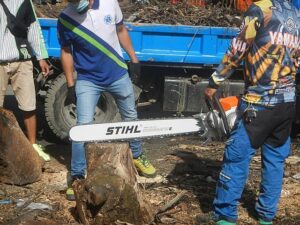As an Amazon Associate, this site earns commissions from qualifying purchases. For more information click here.
A chainsaw is only as good as its chains. After extensive use the time comes when a replacement is due. This often brings up the question: are chainsaw blades universal? Can you install any chain by any manufacturer onto your chainsaw? Knowing the answer to this question is essential for anyone who wants to use this cutting tool.
Chainsaw chains are not interchangeable. They each have a specific gauge and pitch and the replacement must be an exact match with the old one. You can try different brands only if the specifications match with your chain.
How to Choose a Chainsaw Replacement Chain
To replace a chainsaw chain, you have to measure its pitch and gauge. Note down the measurements and use that as a guide to buy a replacement.

There are four ways to do this:
- Check the product manual
- Look on the chainsaw
- Use a chainsaw chain measuring tool
- Take the measurements yourself.
Looking up the chain specs in the manual is obviously the first option. But what if you no longer have it?
You can try and look for it on the chainsaw bar (the arm or blade where the chain is). The information is usually found close to the back where the bar connects to the saw. But if you have a worn out chainsaw it will fade and be hard to read.
A chain measuring tool such as the Oregon is the easiest option. Just put the tool to work and check the readout. If you prefer not to use one, it is easy to do manually.
How to measure the pitch
The pitch refers to the space between the studs or rivets. Calculate the distance between three rivets next to each other. The measurement has to be from the first and third rivet.
Divide the figure by two and you have the chain pitch. The most common measurements are 3/8”, 1/4”, .404” and .325”.
How to measure the gauge
The gauge is the width of the drive links. If you cannot find it on the bar, you can try the following.
- Get a quarter, dime and penny.
- Place each coin into the bar groove successively.
- The one that fits best is the gauge.
The measurements are:
- Dime: .050 inches
- Penny: .058 inches
- Quarter: .063 inches
If none of the coins fit well, the bar groove is most likely .043 inches.
Or you can use a digital caliper as suggested earlier. Put the caliper on the groove where the chain rests on the bar and note the results.
How to measure the bar
If you have to replace the chainsaw bar, measure from the back – right next to the saw body – up to the end (called the length). Take the measurement in inches.
- The most common chainsaw bar sizes range from 12-20 inches.
- Chainsaw bar sizes are in even numbers only. If your bar is 17 inches, buy an 18 inch replacement.
- Gas powered chainsaws begin at 16 inches and go up to 72 inches.
- Electric chainsaw bars are between 14-16 inches.
- Battery operated chainsaws have 16-18 inch bars, while smaller versions use 6-9 inches.
Now that you know what the chain size is, the next step is to figure out what type of chain is best suited for your chainsaw.
Types of Chainsaw Chain Cutters
The type of chainsaw you have will determine what kind of chain to use. If you have an electric chainsaw, use only electric chainsaw chains. If you operate a gas powered saw, use only chains designed for that.
There are many types of chain cutter styles. What you should get depends on what type of cut you want to do.
Low Profile
The low profile chain is the most widely used because it is durable and safe. Low profile chains have special features so kickback can be avoided. If you are a beginner, this is the one to get.
Low profile chains will work for most DIY tasks but is not as durable as other heavy duty chains. How often you need to sharpen depends on the type of cutting you do and its frequency. These chains work well with electric saws in particular and for making slight cuts.
If you have a light powered chainsaw, low profile chains will work nicely. For most garden and outdoor cutting, these will do just fine.
Full Chisel
Full chisel chains are best suited for tree cutting and often used in construction and lumberjacking. It cuts though limbs and wood quickly and efficiently thanks to their squared teeth.
Full chisel is not suitable for beginners because it does not have the safety features of low profile chains. Kickback and other chainsaw injuries can occur if not handled properly. Full chisel chain is also not suitable for fibrous materials like softwood.
Semi Chisel
Semi chisel chains have rounded teeth and suitable for home use. It cuts through frozen, fibrous or dirty wood. It is not the fastest cutter but is reliable and durable.
If you do not mind the slow speed, semi chisel chains are suitable for many tasks. They have safety mechanisms against kickback and come in different variants.
Chipper chain. This is a semi chisel chain that is even more rounded and has an entire radius on the cutting part of the teeth.
Chamfer chain. These chains are designed to cut green and hard dry wood. Instead of a radius, it has a 45 degree chamfer between the plating. These chains are also designed to minimize kickback.
Ripping chain. A ripping chain is used to cut along the wood grain. These are semi chisel chains set at 10 degree angles though some are set at 5 degrees. It costs more than other chains and is often used in milling, making planks and various lumber cuts.
Square Chisel
Square chisels allow for fast and aggressive cutting, which is why it is mostly used by professionals. These chains require a chin grinder for frequent and precise filing. This is a specialty chain and often used for professional and heavy duty work. As the name suggests, their grind profile and radius edges are squared.
Narrow Kerf
Narrow kerf are suitable for homeowners and beginners. Its blades are narrow and light enough for electric and light chainsaws. Narrow kerf chains are ideal for narrow, thin wood cutting.
Just like low profile chains, narrow kerf chains are best suited for light cuts. It is fast, efficient and does not need a high powered chainsaw.
Chain Configuration Options
Once you have chosen a chain, it is time to look at the configuration options. There are many ways to arrange chains but the following are the most common.
Full Skip
There is fewer teeth on the chain and spaced further apart. Use this if you have at least a 24 inch chainsaw and want to cut chunks of wood quickly. It goes through a lot of wood but the cuts will be rough.
The longer the bar the better since you are working with fewer teeth. This is often used for cleanup or when you have to go through a lot of timber.
Semi Skip
A semi skip has more teeth than full skip. Single and double tie straps between the teeth alternate and offers a cleaner cut than full skip. This is also found on blades at least 24 inches long. They can be used to cut various types of wood.
Standard Chain
This is the most common arrangement on chainsaws. It produces the smoothest cuts and is a mainstay in milling. If you have ever seen a smooth plank chances are it was cut with a standard chain configuration. This is also call a full house chain.
When Should I Replace a Chainsaw Chain?
Some chains have wear markers. After several filings and sharpening, the teeth get smaller and worn out. You have to replace the chain once the markers have been reached. Not doing so will reduce performance and could cause damage. In addition there are other signs the chain needs replacement.
If you want to replace the chain or bar, we suggest the Oregon Chainsaw Guide Bar & Chain Combo. It compatible with 18 inch guide bars and various chainsaws from Echo, Ryobi, Makita Homelite and other manufacturers.
Teeth is missing or damaged
Do not use your chainsaw if a tooth is missing, off center or damaged. Sharpening will not resolve this problem and poses an injury risk as the other teeth could fly off.
Incomplete teeth also affects performance and makes cutting less efficient. The sooner you replace the chain the better.
Ragged cuts
If your chainsaw no longer produces smooth, clear cuts, it is time for a replacement. New chains cut smoothly but eventually it gets worn out.
Cuts become jagged and uneven. The cutting experience is not as smooth and the blade dulls quickly. Sharpening only provides a temporary fix and a replacement is more ideal.
Chainsaw smokes when in use
There are many reasons why chainsaws smoke , and one of them is a worn out chain. If you have checked the other possible causes and ruled them out, replace the chain.
Watching smoke come out of your chainsaw can be disconcerting so immediate inspection is necessary. It is never a good thing to see smoke emanating out of your chainsaw.

I love the outdoors and all the tools for maintaining gardens, yards and lawns. The only thing I am more passionate about is sharing what I know about garden and outdoor equipment.


